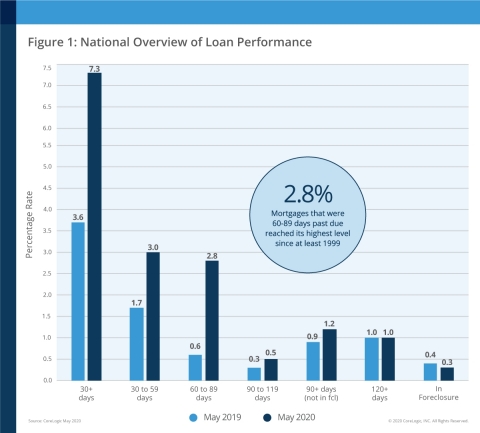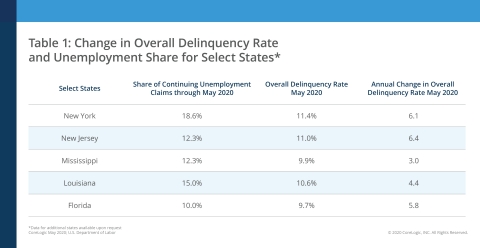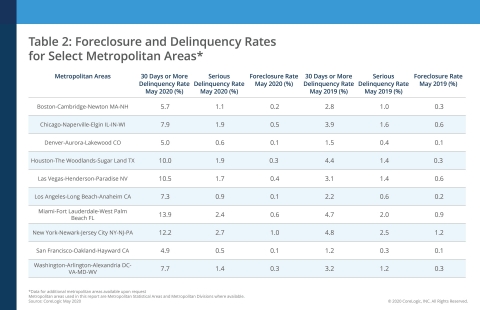IRVINE, Calif.--(BUSINESS WIRE)--CoreLogic® (NYSE: CLGX), a leading global property information, analytics and data-enabled solutions provider, today released its monthly Loan Performance Insights Report for May 2020. On a national level, 7.3% of mortgages were in some stage of delinquency (30 days or more past due, including those in foreclosure). This represents a 3.7-percentage point increase in the overall delinquency rate compared to 3.6% in May 2019.
To gain an accurate view of the mortgage market and loan performance health, CoreLogic examines all stages of delinquency, including the share that transition from current to 30 days past due. In May 2020, the U.S. delinquency and transition rates, and their year-over-year changes, were as follows:
- Early-Stage Delinquencies (30 to 59 days past due): 3%, up from 1.7% in May 2019.
- Adverse Delinquency (60 to 89 days past due): 2.8%, up from 0.6% in May 2019.
- Serious Delinquency (90 days or more past due, including loans in foreclosure): 1.5%, up from 1.3% in May 2019. This is the first year-over-year increase in the serious delinquency rate since November 2010.
- Foreclosure Inventory Rate (the share of mortgages in some stage of the foreclosure process): 0.3%, down from 0.4% in May 2019. This is the second consecutive month the U.S. foreclosure rate was at its lowest level for any month since at least January 1999.
- Transition Rate (the share of mortgages that transitioned from current to 30 days past due): 2.2%, up from 0.8% in May 2019. By comparison, in January 2007 — just before the start of the financial crisis — the current- to 30-day transition rate was 1.2%, while it peaked in November 2008 at 2%.
In the months leading up to the pandemic, U.S. mortgage performance was showing signs of sustained improvement. The national unemployment rate matched a 50-year low in February, and overall delinquency had been on an impressive 27 consecutive-month decline. However, by May 2020 — just two months after the coronavirus (COVID-19) was declared a global pandemic — U.S. unemployment surged past 13%, leaving over 4 million homeowners (accounting for more than 8% of all mortgages) little choice but to enter a COVID-19 mortgage forbearance program.
“The national unemployment rate soared from a 50-year low in February 2020, to an 80-year high in April,” said Dr. Frank Nothaft, chief economist at CoreLogic. “With the sudden loss of income, many homeowners are struggling to stay on top of their mortgage loans, resulting in a jump in non-payment.”
Absent further government programs and support, CoreLogic forecasts the U.S. serious delinquency rate to quadruple by the end of 2021, pushing 3 million homeowners into serious delinquency.
“Government and industry relief programs have helped to cushion the initial financial blow of the pandemic for millions of U.S. homeowners,” said Frank Martell, president and CEO of CoreLogic. “COVID-19 and the resulting pressures continue to influence the economic activity of many households. Barring additional intervention from the Federal and State governments, we are likely to see meaningful spikes in delinquencies over the short to medium term.”
All states logged increases in overall delinquency rates in May from a year earlier. New Jersey and Nevada, both still hot spots for the virus, experienced the largest overall delinquency gains with 6.4 percentage-point increases each in May, compared to one year earlier. New York again remained atop the list with a 6.1 percentage-point increase, while Florida experienced a gain of 5.8 percentage points.
On the metro level, nearly every U.S. metropolitan area posted at least a small annual increase in their overall delinquency rate, with tourism destinations such as Miami, Florida (up 9.2 percentage points), and Kahului, Hawaii (up 8.8 percentage points), posting two of the largest increases. Odessa, Texas — which has a local economy strongly tied to the oil industry — also logged a considerable increase, posting an annual gain of 9 percentage points.
Meanwhile, over 75% of all metro areas logged at least a small increase in their serious delinquency rate. Odessa, Texas, and Laredo, Texas, tied for largest increase with gains of 1.1 percentage points each. McAllen, Texas; Midland, Texas and Hattiesburg, Mississippi all followed with gains of 0.7 percentage-points each.
To learn more firsthand information about delinquency and foreclosure trends, join Dr. Frank Nothaft and other leading mortgage experts from CoreLogic during their virtual roundtable this Thursday, August 13, to discuss these various issues at hand. Register for the webinar today here.
The next CoreLogic Loan Performance Insights Report will be released on September 8, 2020, featuring data for June 2020. For ongoing housing trends and data, visit the CoreLogic Insights Blog: www.corelogic.com/insights.
Methodology
The data in The CoreLogic LPI report represents foreclosure and delinquency activity reported through May 2020. The data in this report accounts for only first liens against a property and does not include secondary liens. The delinquency, transition and foreclosure rates are measured only against homes that have an outstanding mortgage. Homes without mortgage liens are not subject to foreclosure and are, therefore, excluded from the analysis. CoreLogic has approximately 75% coverage of U.S. foreclosure data.
Source: CoreLogic
The data provided is for use only by the primary recipient or the primary recipient's publication or broadcast. This data may not be re-sold, republished or licensed to any other source, including publications and sources owned by the primary recipient's parent company without prior written permission from CoreLogic. Any CoreLogic data used for publication or broadcast, in whole or in part, must be sourced as coming from CoreLogic, a data and analytics company. For use with broadcast or web content, the citation must directly accompany first reference of the data. If the data is illustrated with maps, charts, graphs or other visual elements, the CoreLogic logo must be included on screen or website. For questions, analysis or interpretation of the data, contact Allyse Sanchez at corelogic@ink-co.com. Data provided may not be modified without the prior written permission of CoreLogic. Do not use the data in any unlawful manner. This data is compiled from public records, contributory databases and proprietary analytics, and its accuracy is dependent upon these sources.
About CoreLogic
CoreLogic (NYSE: CLGX), the leading provider of property insights and solutions, promotes a healthy housing market and thriving communities. Through its enhanced property data solutions, services and technologies, CoreLogic enables real estate professionals, financial institutions, insurance carriers, government agencies and other housing market participants to help millions of people find, buy and protect their homes. For more information, please visit www.corelogic.com.
CORELOGIC and the CoreLogic logo are trademarks of CoreLogic, Inc. and/or its subsidiaries. All other trademarks are the property of their respective owners.






